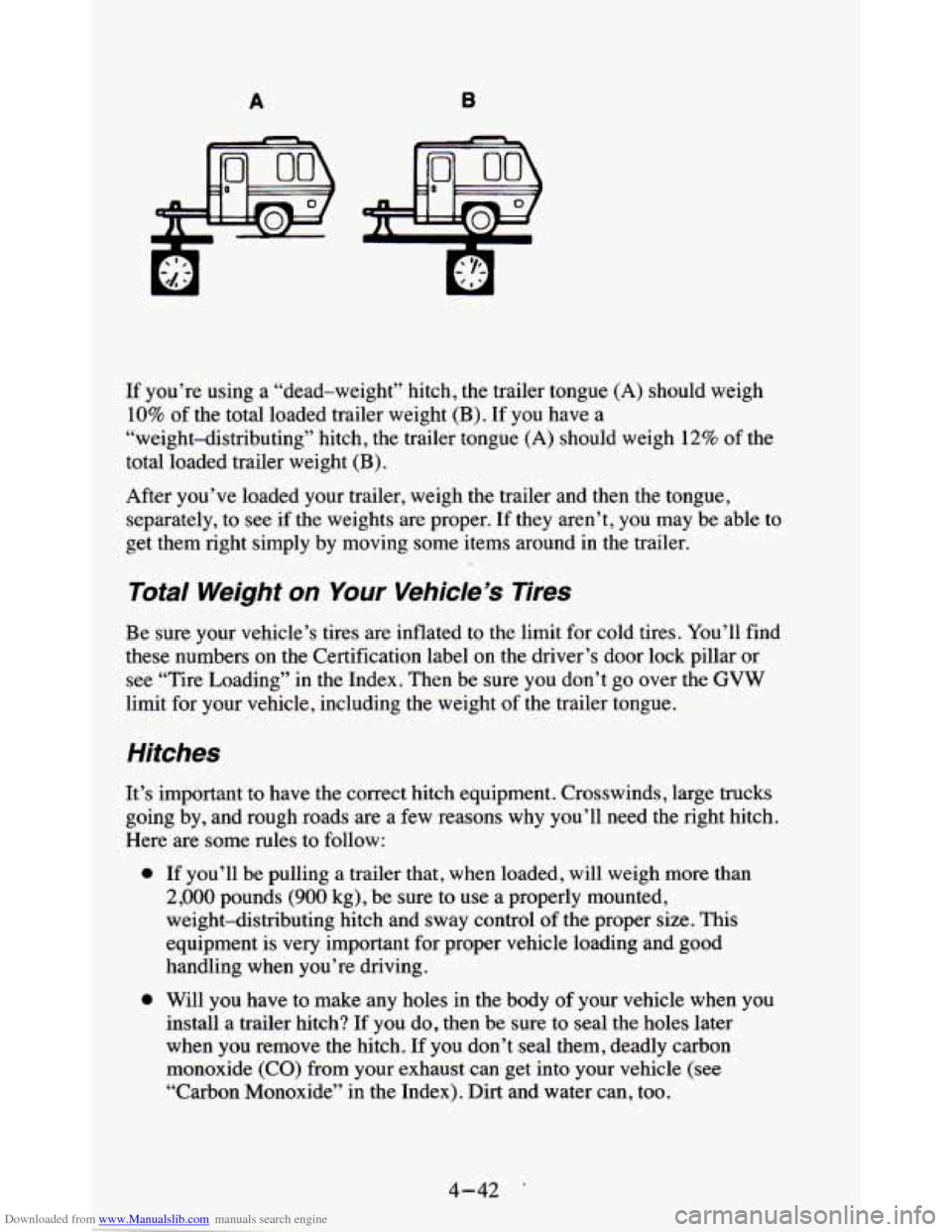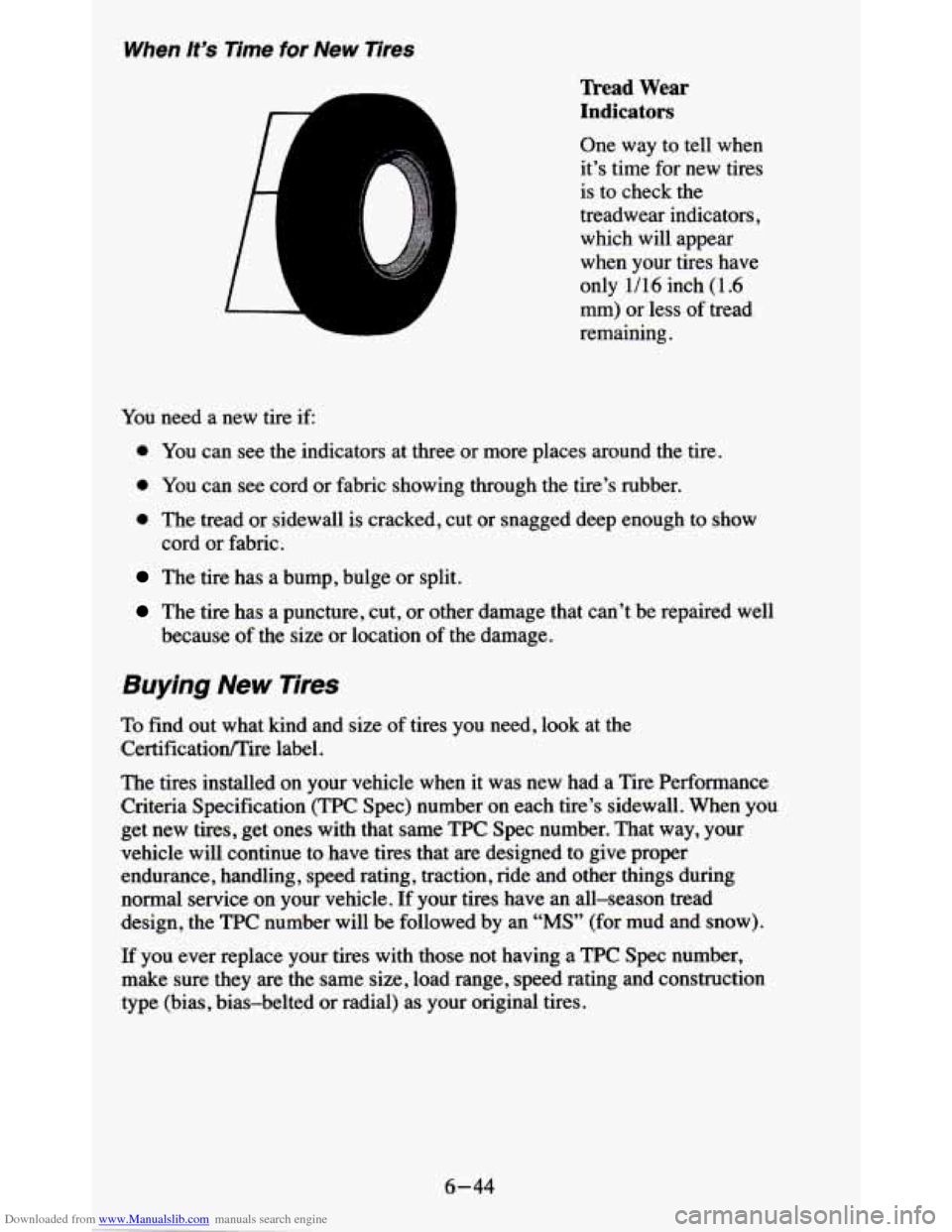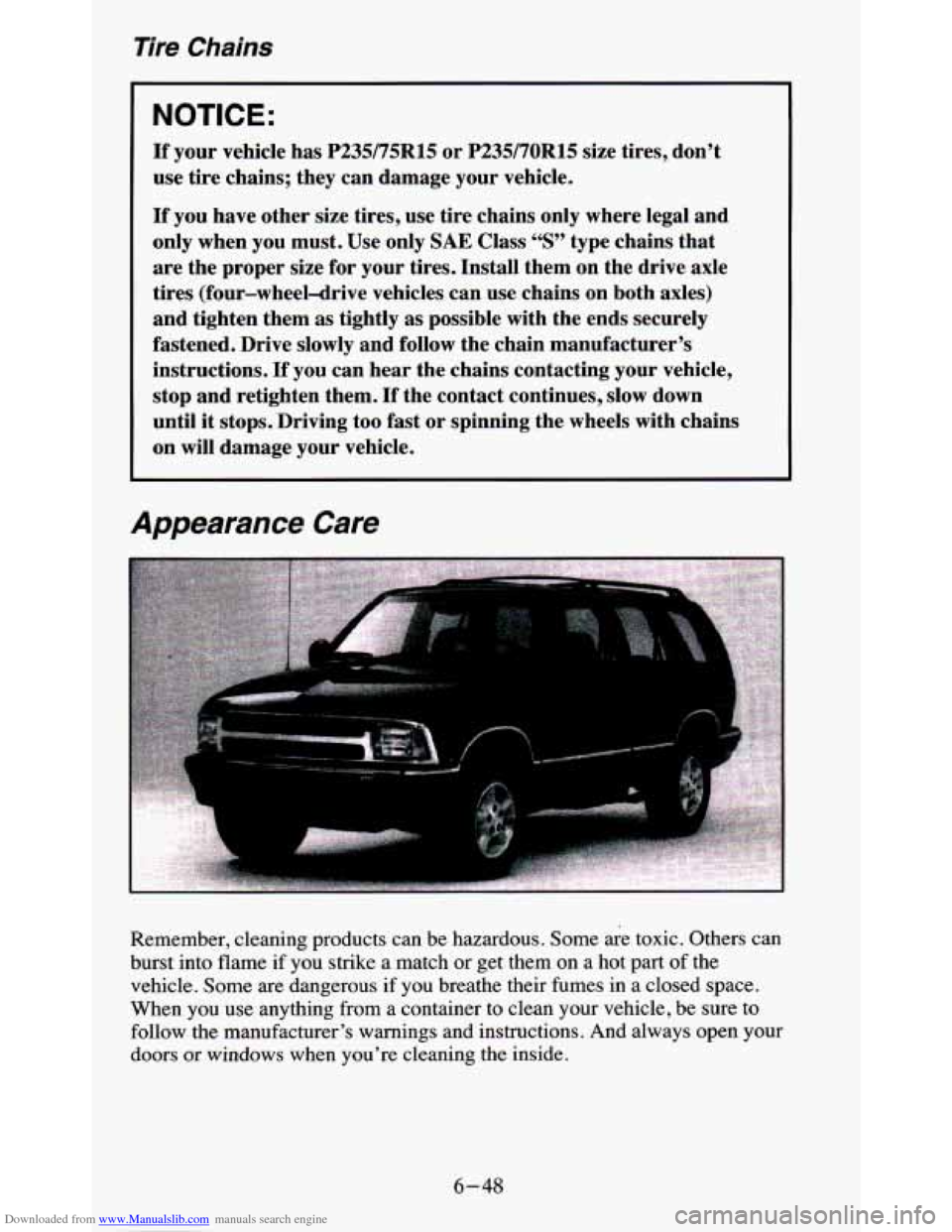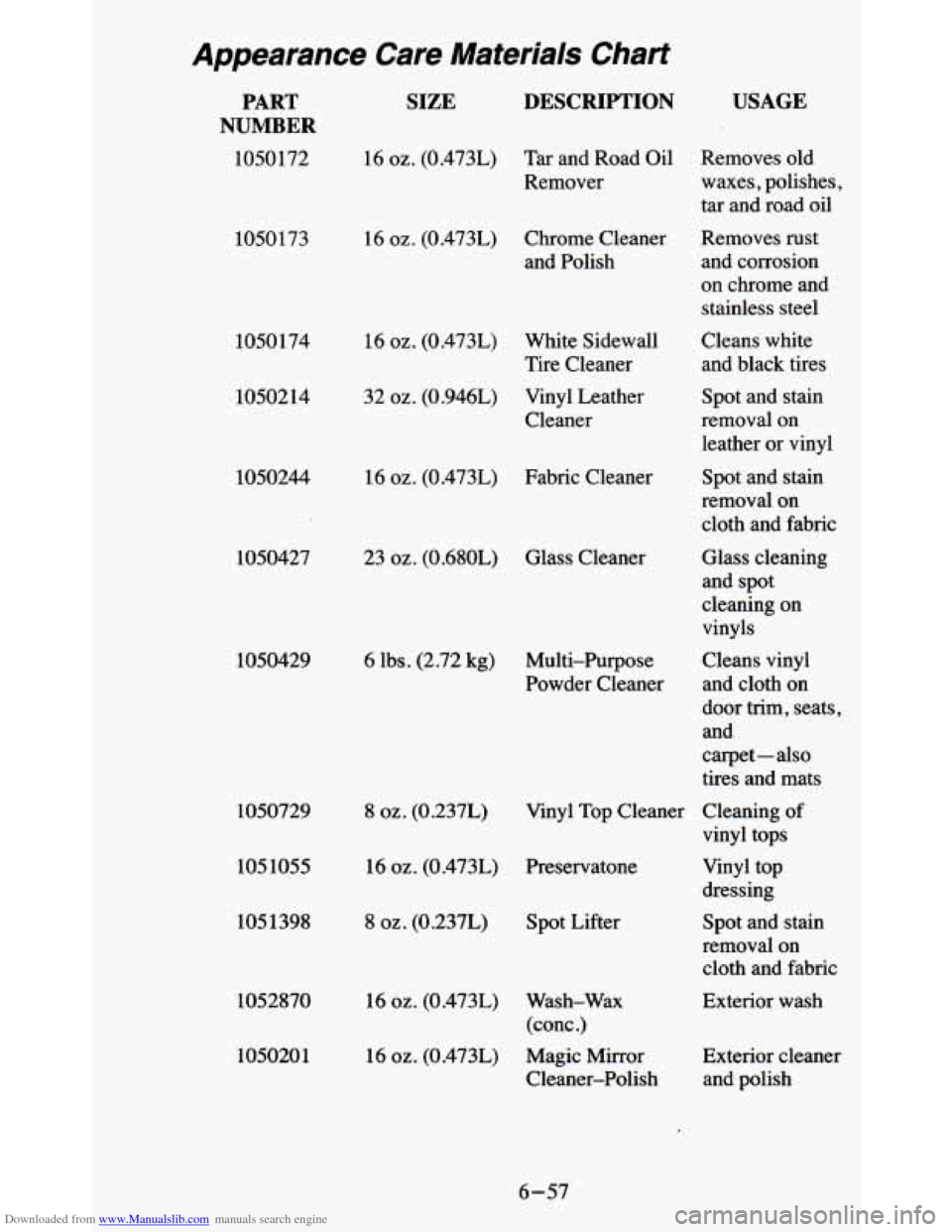tire size CHEVROLET BLAZER 1995 2.G Owners Manual
[x] Cancel search | Manufacturer: CHEVROLET, Model Year: 1995, Model line: BLAZER, Model: CHEVROLET BLAZER 1995 2.GPages: 380, PDF Size: 20.04 MB
Page 196 of 380

Downloaded from www.Manualslib.com manuals search engine A B
If you’re using a “dead-weight” hitch, the trailer tongue (A) should weigh
10% of the total loaded trailer weight (B). If you have a
“weight-distributing” hitch, the trailer tongue
(A) should weigh 12% of the
total loaded trailer weight (B).
After you’ve loaded your trailer, weigh the trailer and then the tongue,
separately, to see if the weights are proper.
If they aren’t, you may be able to
get them right simply by moving some items around in the trailer.
Total Weight on Your Vehicle’s Tires
Be sure your vehicle’s tires are inflated to the limit for cold tires. You’ll find
these numbers on the Certification label
on the driver’s door lock pillar or
see “Tire Loading” in the Index. Then be sure you don’t go over the
GVW
limit for your vehicle, including the weight of the trailer tongue.
Hitches
It’s important to have the correct hitch equipment. Crosswinds, large trucks
going by, and rough roads are a
few reasons why you’ll need the right hitch.
Here are some rules to follow:
0 If you’ll be pulling a trailer that, when loaded, will weigh more than
2,000 pounds (900 kg), be sure to use a properly mounted,
weight-distributing hitch and sway control of the proper size. This
equipment is very important for proper vehicle loading and good
handling when you’re driving.
0 Will you have to make any holes in the body of your vehicle when you
install
a trailer hitch? If you do, then be sure to seal the holes later
when you remove the hitch. If you don’t seal them, deadly carbon
monoxide
(CO) from your exhaust can get into your vehicle (see
“Carbon Monoxide” in the Index). Dirt and water can, too.
4-42
Page 284 of 380

Downloaded from www.Manualslib.com manuals search engine When It’s Time for New Tires
Tkead Wear
Indicators
One way to tell when
it’s time for new tires
is to check the
treadwear indicators,
which will appear
when your tires have
only
1/16 inch (1.6
mm) or less
of tread
remaining.
You need a new tire if
0 You can see the indicators at three or more places around the tire.
0 You can see cord or fabric showing through the tire’s rubber.
0 The tread or sidewall is cracked, cut or snagged deep enough to show
cord or fabric.
The tire has a bump, bulge or split.
The tire has a puncture, cut, or other damage that can’t be repaired well
because of the size or location of the damage.
Buying New Tires
To find out what kind and size of tires you need, look at the
Certificatioflire label.
The tires installed on your vehicle when it was new had a Tire Performance
Criteria Specification (TPC Spec) number on each tire’s sidewall. When
you
get new tires, get ones with that same TPC Spec number. That way, your
vehicle
will continue to have tires that are designed to give proper
endurance, handling, speed rating, traction, ride and other things during
normal service on your vehicle. If your tires have an all-season tread
design, the TPC number will be followed by an
“MS” (for mud and snow).
If you ever replace your tires with those not having a TPC Spec number,
make sure they are the same size, load range, speed rating and construction
type (bias, bias-belted or radial) as your original tires.
6-44
Page 288 of 380

Downloaded from www.Manualslib.com manuals search engine Tire Chains
NOTICE:
If your vehicle has P235/75R15 or P235/70R15 size tires, don’t
use tire chains; they can damage your vehicle.
If you have other size tires, use tire chains only where legal and
only when you must. Use only
SAE Class “S” type chains that
are the proper size for your tires. Install them on the drive axle
tires (four-wheeldrive vehicles can use chains on both axles)
and tighten them as tightly
as possible with the ends securely
fastened. Drive slowly and follow the chain manufacturer’s
instructions.
If you can hear the chains contacting your vehicle,
stop and retighten them.
If the contact continues, slow down
until it stops. Driving too fast or spinning the wheels with chains
on will damage your vehicle.
Appearance Care
Remember, cleaning products can be hazardous. Some are toxic. Others can
burst into flame if you strike a match or get them on a hot part
of the
vehicle. Some are dangerous if you breathe their fumes in a closed space.
When you use anything from a container to clean your vehicle, \
be sure
to
follow the manufacturer’s warnings and instructions. And always open your\
doors
or windows when you’re cleaning the inside.
6-48
Page 297 of 380

Downloaded from www.Manualslib.com manuals search engine Appearance Care Materials Chart
DESCRIPTION USAGE PART
NUMBER
1050172
SIZE
16 oz. (0.473L) Tar and Road Oil Removes old
Remover waxes, polishes,
tar and road oil
16 oz. (0.473L) Chrome Cleaner Removes rust
and Polish and corrosion on chrome and
stainless steel 1050173
1050174 16
oz. (0.473L) White Sidewall Cleans white
Tire Cleaner and black tires
1050214 32 oz. (0.946L) Vinyl Leather
Cleaner Spot
and stain
removal on
leather or vinyl
16 oz. (0.473L) Fabric Cleaner Spot and stain
removal
on
cloth and fabric
1050244
23 oz. (0.680L)
Glass Cleaner 1050427 Glass cleaning
and spot
cleaning on vinyls
1050429 6 lbs. (2.72 kg) Multi-Pufpose Powder Cleaner Cleans vinyl
and
cloth on
door trim, seats,
and
carpet
- also
tires and mats
1050729 8 oz. (0.237L) Vinyl Top Cleaner Cleaning of
vinyl tops
105 1055
1051398 16
oz. (0.473L) Preservatone
Vinyl top
dressing
8 oz. (0.237L) Spot Lifter Spot and stain
removal on
cloth and fabric
1052870
16 oz. (0.473L) Wash-Wax
16 oz. (0.473L) Magic Mirror (conc
.)
Cleaner-Polish Exterior wash
1050201 Exterior
cleaner
and
polish
6-57